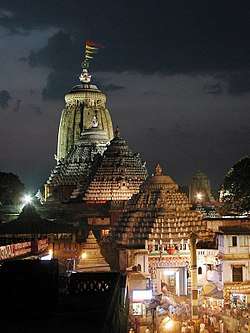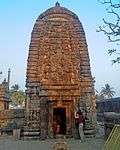Eastern Ganga dynasty
| Eastern Ganga Empire | |||||||
|---|---|---|---|---|---|---|---|
| 1078–1434 | |||||||
| Capital |
Dantapura Kalinganagara Kataka | ||||||
| Religion | Hinduism | ||||||
| Government | Monarchy | ||||||
| Tri-Kalingadhipati | |||||||
• 1078–1147 | Anantavarman Chodagangadeva | ||||||
• 1178–1198 | Ananga Bhima Deva II | ||||||
• 1238–1264 | Narasimha Deva I | ||||||
• 1414–1434 | Bhanu Deva IV | ||||||
| Historical era | Classical India | ||||||
• Established | 1078 | ||||||
• Disestablished | 1434 | ||||||
| |||||||
The Eastern Ganga dynasty or Chodaganga dynasty[1] was a medieval Indian dynasty that reigned from Kalinga from the 11th century to the early 15th century. The territory ruled by the dynasty consisted of the whole of the modern-day Indian state of Odisha as well as parts of West Bengal, Andhra Pradesh and Chhattisgarh.[2] The early rulers of the dynasty ruled from Dantapura; the capital was later moved to Kalinganagara (modern Mukhalingam), and ultimately to Kataka (modern Cuttack).[3] Today, they are most remembered as the builders of the Konark Sun Temple, a UNESCO World Heritage site at Konark, Odisha.
The dynasty was founded by King Anantavarman Chodaganga, descendants of the Western Ganga Dynasty[4] that rule southern parts of modern Karnataka and the Chola dynasty. The Eastern Ganga rulers were matrimonially related to the Cholas and Eastern Chalukyas. Their currency was called Ganga fanams and was greatly influenced by the Cholas and Eastern Chalukyas of southern India.[5] Anantavarman was a religious person as well as a patron of art and literature. He is credited for having built the famous Jagannath Temple of Puri in Odisha.[6] King Anantavarman Chodagangadeva was succeeded by a long line of illustrious rulers such as Narasimha Deva I (1238–1264).
The rulers of Eastern Ganga dynasty defended their kingdom from the constant attacks of the Muslim rulers. This kingdom prospered through trade and commerce and the wealth was mostly used in the construction of temples. The rule of the dynasty came to an end under the reign of King Bhanudeva IV (1414–34), in the early 15th century.[7]
Background
After the fall of Mahameghavahana dynasty, Kalinga was divided into different kingdoms under feudatory chiefs. Each of these chiefs bore the title Kalingadhipathi (Lord of Kalinga). The beginnings of what became the Eastern Ganga dynasty came about when Indravarma I defeated the Vishnukundin king, Indrabhattaraka and established his rule over the region with Kalinganagara (or Mukhalingam) as his capital, and Dantapura as a secondary capital. The Ganga kings assumed various titles viz. Trikalingadhipathi or Sakala Kalingadhipathi (Lord of three Kalinga or all three Kalingas namely Kalinga proper (South), Utkala (North), and Kosala (West)).
Mukhalingam near Srikakulam of Andhra Pradesh bordering Odisha has been identified as Kalinganagara, the capital of the early Eastern Gangas.[8]
After the decline of the early Eastern Gangas reign, the Chalukyas of Vengi took control of the region. Vajrahastha I, a descendant of the early Eastern Ganga dynasty took advantage of the internal strife and revived the power of the Ganga dynasty. It was during their rule that Shaivism took precedence over Buddhism and Jainism. The magnificent Srimukhalingam Temple at Mukhalingam was built during this period.
In the 11th century, the Cholas brought the Ganga Kingdom under their rule.[8]
Intermarriage
The Eastern Gangas were known to have intermarried with the Cholas as well as Chalukyas. The early state of the dynasty may have started from the early 8th century.
Anantavarman Chodaganga

The dynastic founding started with Anantavarman Chodaganga. He is believed to have ruled from the Ganges River in the north to the Godavari River in the south. This laying the foundation of the Eastern Ganga Dynasty. Also during his rule, the great Jagannath Temple at Puri was being built.[8] He assumed the title of Trikalingadhipathi (ruler of the three Kalingas which comprise Kalinga proper, Utkala north and Koshala west) in 1076. Resulting in him being the first to rule all three divisions of Kalinga.[6]
Intrudes
Rajaraja III ascended the throne in 1198 and did nothing to resist the Muslims of Bengal, who invaded Orissa in 1206. Rajaraja's son Anangabhima III, however, repulsed the Muslims and built the temple of Megheshvara at Bhuvaneshvara. Narasimhadeva I, the son of Anangabhima, invaded southern Bengal in 1243, defeated its Muslim ruler, captured the capital (Gauda), and built the Sun Temple at Konark to commemorate his victory. With the death of Narasimha in 1264, the Eastern Gangas began to decline; the sultan of Delhi invaded Odisha in 1324, and Musunuri Nayaks defeated the Odishan powers in 1356. Narasimha IV, the last known king of the Eastern Ganga dynasty, ruled until 1425. The "mad king," Bhanudeva IV, who succeeded him, left no inscriptions; his minister Kapilendra usurped the throne and founded the Suryavamsha dynasty in 1434–35.
Legacy
The Eastern Gangas were great patrons of religion and the arts, and the temples of the Ganga period rank among the masterpieces of Hindu architecture.[9]
Rulers
- Indravarman (496–535)[8]
- Devendravarman IV (893-?)
- Vajrahasta Anantavarman (1038-?)
- Rajaraja I (?-1078)
- Anantavarman Chodaganga (1078–1150)[8]
- Ananga Bhima Deva II (1178–1198)
- Rajaraja II (1198–1211)
- Ananga Bhima Deva III (1211–1238)
- Narasimha Deva I (1238–1264)[8]
- Bhanu Deva I (1264–1279)
- Narasimha Deva II (1279–1306)[8]
- Bhanu Deva II (1306–1328)
- Narasimha Deva III (1328–1352)
- Bhanu Deva III (1352–1378)
- Narasimha Deva IV (1379–1424)[8]
- Bhanu Deva IV (1424–1434)
Gallery
 A Temple in Sri Mukhalingam temple complex
A Temple in Sri Mukhalingam temple complex Konark Sun Temple at Konark, Orissa, built by King Narasimhadeva I (1238–1264),[8] it is now a World Heritage Site.
Konark Sun Temple at Konark, Orissa, built by King Narasimhadeva I (1238–1264),[8] it is now a World Heritage Site. A Stone carved throne at Simhachalam temple
A Stone carved throne at Simhachalam temple A Fanam (Coin) of Eastern Ganga Dynasty[10]
A Fanam (Coin) of Eastern Ganga Dynasty[10]
See also
References
- ↑ The Second Pandyan empire, A.D. 1190–1312 by A.J. Thinakaran, 1987, p.63
- ↑ Ganga Dynasty britannica.com. Archived November 10, 2007, at the Wayback Machine.
- ↑ B. Hemalatha (1991). Life in medieval northern Andhra. Navrang.
- ↑ Satya Prakash; Rajendra Singh (1986). Coinage in Ancient India: a numismatic, archaeochemical and metallurgical study of ancient Indian coins. Govindram Hasanand. p. 348. ISBN 978-81-7077-010-7.
- ↑ Patnaik, Nihar Ranjan (1 January 1997). Economic History of Orissa. Indus Publishing. p. 93. ISBN 978-81-7387-075-0. Retrieved 16 February 2015.
- 1 2 Eastern Ganga Dynasty in India. India9.com (2005-06-07). Retrieved on 2013-07-12.
- ↑ Archived April 10, 2009, at the Wayback Machine.
- 1 2 3 4 5 6 7 8 9 Sen, Sailendra (2013). A Textbook of Medieval Indian History. Primus Books. pp. 36–37. ISBN 978-93-80607-34-4.
- ↑ Ganga dynasty (Indian dynasties) - Encyclopædia Britannica. Britannica.com. Retrieved on 2013-07-12.
- ↑ Michael Mitchiner (1979). Oriental Coins & Their Values : Non-Islamic States and Western Colonies A.D. 600-1979. Hawkins Publications. ISBN 978-0-904173-18-5.
External links
| Wikimedia Commons has media related to Eastern Ganga Dynasty. |
| Timeline and cultural period |
Northwestern India (Punjab-Sapta Sindhu) |
Indo-Gangetic Plain | Central India | Southern India | ||
| Upper Gangetic Plain (Kuru-Panchala) |
Middle Gangetic Plain | Lower Gangetic Plain | ||||
| IRON AGE | ||||||
| Culture | Late Vedic Period | Late Vedic Period (Brahmin ideology)[lower-alpha 1] Painted Grey Ware culture |
Late Vedic Period (Kshatriya/Shramanic culture)[lower-alpha 2] Northern Black Polished Ware |
Pre-history | ||
| 6th century BC | Gandhara | Kuru-Panchala | Magadha | Adivasi (tribes) | ||
| Culture | Persian-Greek influences | "Second Urbanisation" Rise of Shramana movements Jainism - Buddhism - Ājīvika - Yoga |
Pre-history | |||
| 5th century BC | (Persian rule) | Shishunaga dynasty | Adivasi (tribes) | |||
| 4th century BC | (Greek conquests) | Nanda empire | ||||
| HISTORICAL AGE | ||||||
| Culture | Spread of Buddhism | Pre-history | Sangam period (300 BC – 200 AD) | |||
| 3rd century BC | Maurya Empire | Early Cholas Early Pandyan Kingdom Satavahana dynasty Cheras 46 other small kingdoms in Ancient Thamizhagam | ||||
| Culture | Preclassical Hinduism[lower-alpha 3] - "Hindu Synthesis"[lower-alpha 4] (ca. 200 BC - 300 AD)[lower-alpha 5][lower-alpha 6] Epics - Puranas - Ramayana - Mahabharata - Bhagavad Gita - Brahma Sutras - Smarta Tradition Mahayana Buddhism |
Sangam period (continued) (300 BC – 200 AD) | ||||
| 2nd century BC | Indo-Greek Kingdom | Shunga Empire Maha-Meghavahana Dynasty |
Early Cholas Early Pandyan Kingdom Satavahana dynasty Cheras 46 other small kingdoms in Ancient Thamizhagam | |||
| 1st century BC | ||||||
| 1st century AD | Kuninda Kingdom | |||||
| 2nd century | Kushan Empire | |||||
| 3rd century | Kushano-Sasanian Kingdom | Kushan Empire | Western Satraps | Kamarupa kingdom | Kalabhra dynasty Pandyan Kingdom(Under Kalabhras) | |
| Culture | "Golden Age of Hinduism"(ca. AD 320-650)[lower-alpha 7] Puranas Co-existence of Hinduism and Buddhism | |||||
| 4th century | Kidarites | Gupta Empire Varman dynasty |
Kalabhra dynasty Pandyan Kingdom(Under Kalabhras) Kadamba Dynasty Western Ganga Dynasty | |||
| 5th century | Hephthalite Empire | Alchon Huns | Kalabhra dynasty Pandyan Kingdom(Under Kalabhras) Vishnukundina | |||
| 6th century | Nezak Huns Kabul Shahi |
Maitraka | Adivasi (tribes) | Badami Chalukyas Kalabhra dynasty Pandyan Kingdom(Under Kalabhras) | ||
| Culture | Late-Classical Hinduism (ca. AD 650-1100)[lower-alpha 8] Advaita Vedanta - Tantra Decline of Buddhism in India | |||||
| 7th century | Indo-Sassanids | Vakataka dynasty Empire of Harsha |
Mlechchha dynasty | Adivasi (tribes) | Pandyan Kingdom(Under Kalabhras) Pandyan Kingdom(Revival) Pallava | |
| 8th century | Kabul Shahi | Pala Empire | Pandyan Kingdom Kalachuri | |||
| 9th century | Gurjara-Pratihara | Rashtrakuta dynasty Pandyan Kingdom Medieval Cholas Pandyan Kingdom(Under Cholas) Chera Perumals of Makkotai | ||||
| 10th century | Ghaznavids | Pala dynasty Kamboja-Pala dynasty |
Kalyani Chalukyas Medieval Cholas Pandyan Kingdom(Under Cholas) Chera Perumals of Makkotai Rashtrakuta | |||
References and sources for table References Sources
| ||||||